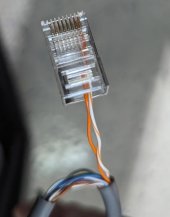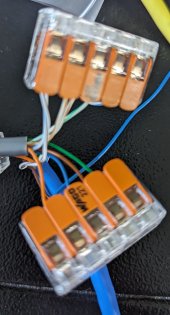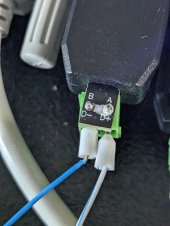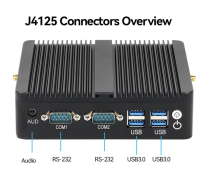solarhombre
New Member
Hi there!
[Linked to all the things I used, no affiliate links]
As part of my battery monitoring setup, I wanted to avoid having those ethernet splitters around since my space is limited and I already have an UPS and a mini PC on top of the EG4 battery rack with 6 EG4-LLv2 batteries in it. I figured I'd share this setup since I haven't seen anything like it in this forum.
Going with what I had around, I used a piece of ethernet cable which, as you know, has 8 wires in it as 4 color-coded pairs.
* I crimped each of those pairs to a separate ethernet connector, on pins 7 and 8, with the solid wire in each pair going to pin 8.

* Each ethernet connector is about 7" or 8" apart from the previous one, to match the space between RS485 connections in the batteries mounted in the rack.

* Then all those wires go into 2 wagos: one for the solid colored wires and one for the others. They are 23 or 24 AWG and you can insert more than one wire per slot.

* And finally connected 2 more wires, solid and striped, from the wagos to my RS485 dongle, with the solid color wire going to B- and the other to A+ (pardon my crimping, wire was smaller than the ferrule . All solid wires come from the ethernet pin 8 and are connected to B-, the others come from pin 7 and are connected to A+:
. All solid wires come from the ethernet pin 8 and are connected to B-, the others come from pin 7 and are connected to A+:

When I'm done with experiments, the wagos will be inside of the rack, on top of the first battery, and 2 tiny wires will come out from the hole on the left.
Please, share your RS485 bus setup, specially if you have something "minimalistic" like this.
Thanks.
[Linked to all the things I used, no affiliate links]
As part of my battery monitoring setup, I wanted to avoid having those ethernet splitters around since my space is limited and I already have an UPS and a mini PC on top of the EG4 battery rack with 6 EG4-LLv2 batteries in it. I figured I'd share this setup since I haven't seen anything like it in this forum.
Going with what I had around, I used a piece of ethernet cable which, as you know, has 8 wires in it as 4 color-coded pairs.
* I crimped each of those pairs to a separate ethernet connector, on pins 7 and 8, with the solid wire in each pair going to pin 8.

* Each ethernet connector is about 7" or 8" apart from the previous one, to match the space between RS485 connections in the batteries mounted in the rack.

* Then all those wires go into 2 wagos: one for the solid colored wires and one for the others. They are 23 or 24 AWG and you can insert more than one wire per slot.

* And finally connected 2 more wires, solid and striped, from the wagos to my RS485 dongle, with the solid color wire going to B- and the other to A+ (pardon my crimping, wire was smaller than the ferrule

When I'm done with experiments, the wagos will be inside of the rack, on top of the first battery, and 2 tiny wires will come out from the hole on the left.
Please, share your RS485 bus setup, specially if you have something "minimalistic" like this.
Thanks.



